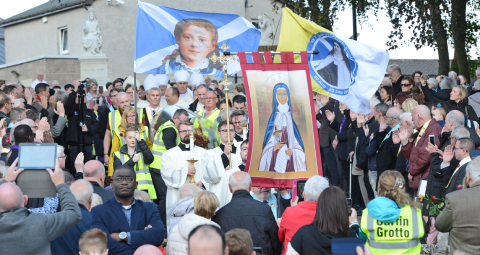September 20 | ![]() 0 COMMENTS
0 COMMENTS ![]() print
print

The legacy of St Thérèse’s visit to Scotland will be a renewed Faith
The coordinator of the relics tour, Fr James Grant, looks back on an incredible three weeks
These last few months of my life have been consumed by the preparation for this visit of the relics of St Thérèse of Lisieux and the last two weeks and more have been exhausting. It has also been exhilarating, however, as I see how the Little Flower has been welcomed and received by the Scottish people young and old. Gratifyingly, it means that all the sleepless nights and mentally demanding moments of the last few months have been worth it.
As I travelled Scotland accompanying the relics and encountered the enormous crowds who turned up to honour and venerate the relics, I could not help but ask what is it about this little saint that draws the crowds, everywhere she goes throughout the world. Why is it that so many thousands of churches throughout the world have a statue or an image to this little French saint who, at 15, had hidden herself away in a convent and was known to very few outside her own family, for nine years lived an enclosed life and died at 24, whose funeral was attended by only a couple of dozen people but who now draws thousands upon thousands everywhere her relics travel throughout the world.
In other words, what is it about St Thérèse that people find so appealing?
I have come to the conclusion that what draws us to this little saint is her childlike simplicity, as communicated in her diary, Story of a Soul. We cannot help but be attracted to the innocence of children and this is what I believe appeals to people when they reflect on the life of Marie Françoise-Thérèse Martin, the Little Flower as we so affectionately know her.
By way of background, we must remember that Thérèse lived at a time when a pessimistic view of the human condition prevailed over people’s spiritual lives. There was a strong belief in a God who punished the sinner. There was a sense of pessimism that people were essentially bad, and the world was filled with temptations to be avoided.
The practice of religion in France was narrow and rule-bound. There was a sense that we were required to earn God’s love by our good deeds and our avoidance of life’s temptations which would take our sights off the final goal which was Heaven.
The Martin family was influenced by this way of thinking. But along comes this little child, Thérèse Martin, and with childlike simplicity has a very different take on God—a God who loves us, in spite of our faults. A God who thirsts for our love, rather than our fear.
Childlike
In describing her First Holy Communion she talked of it as being her first loving kiss from Jesus. Yes, that is a very childlike way of describing this beautiful encounter we have with the Lord when we receive Him in Holy Communion—‘A kiss from Jesus’—but it is no less eloquent for all that. It is this childlike innocent simplicity that endears the Little Flower to so many.
The child in Thérèse Martin managed to convert all the events of her life, great and small, into love—and only love counts in the end. In the midst of this pessimistic outlook of a strict and punishing God where holiness was only attainable by our most heroic and gruelling efforts and reserved for the few, Thérèse revealed a way to holiness that is within the reach of all, devoid of all fear and timidity in approaching God.
Thérèse blazed a trail by centring herself on a God of compassion who welcomes sinners and ‘little ones.’ Thérèse’s teaching has so entered into the mainstream of Catholic consciousness that we now take it for granted. But for her time this was quite a revolutionary approach to God.
Her diary reveals an ordinary young woman who through uncomplicated simplicity had attained sanctity by a path all could recognise and claim as their own. People loved her, not merely admired her. The thousands who read her autobiography clamoured for her canonisation for she reminded us all that we are loved by a God who loves us in spite of our faults and who thirsts for our love, rather than our fear.
That is the kind of God that Thérèse the missionary came to preach to the people of Scotland. God is not a cruel, judging and punishing God. He is our loving and forgiving Heavenly Father who wants to save everyone through His Son Jesus, a God who never writes anyone off, a God who is always in search of His lost and straying children.
That is why her message is as relevant today as it was for the men and women of yesterday because it is pure Gospel teaching, perennially valid, ancient yet ever new.
God’s love
In today’s secular and increasingly fragmented world where God is mostly ignored and largely unheeded, people need more than ever to hear the message that there is a God who loves them and to whom they are precious in spite of their faults. His one desire is they come to know Him, experience His love and so love Him in return by loving others. Ultimately it is the call or the vocation to holiness to which we are all called and St Thérèse reveals to us in her ‘Little Way’ how to achieve this.
The Little Flower tells us that holiness (closeness to or intimacy with God) is God’s gift and that it is achievable and freely available to all. If we want this gift, we can have it. It is as simple as that. We have only to give ourselves to the particular life God has given us, and to do so with love. As Thérèse wrote: “It’s love I ask for, love is all the skill I need.”
There has long been a devotion to the Little Flower in Scotland so passionately promoted in its earliest years through the sterling efforts of the redoubtable Canon Thomas Nimmo Taylor. Years before her beatification and canonisation, Scottish Catholics invoked her intercession thanks to the influence of this champion of Thérèse’s virtues, the parish priest of Carfin and founder of Carfin Grotto.
Being brought up only a few miles from the Grotto, from my earliest years I was familiar with the story of the Little Flower and aware of the reverence in which she was held. For that reason, coordinating this visit of St Thérèse to Scotland must rank as one of the most privileged moments of my priesthood. It has certainly been a mammoth task but an immense honour to bring this little saint to visit the people of this little corner of God’s vineyard in which she is so loved.
Giving thanks
I would want to place on record my thanks to all the diocesan coordinators and the many others who assisted me in every way—it has truly been a team effort. If I were to single out anyone, it would have to be Sancta Familia Media, the team from my former parish, who helped me in promoting the visit and whose reporting of the relics pilgrimage throughout Scotland ensured that so many could follow the Little Flower as she travelled our country.
Their coverage has been nothing less than outstanding and I know has been appreciated by thousands who have tuned in regularly to their daily posts. On behalf of all I would like to express my profound thanks.
As I now prepare to travel with the relics back to Lisieux, my sincere prayer and heartfelt wish is that Thérèse’s visit to our land will bear much fruit. To quote the last two lines of that lovely hymn composed by the Carmelites of Dysart: “Saint Thérèse, through your ‘Little Way’, all Scotland’s faith renew.”
St Thérèse of Lisieux, pray for us and pray for Scotland.
– Fr James Grant is general secretary of the Bishops’ Conference of Scotland










